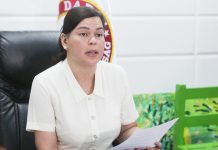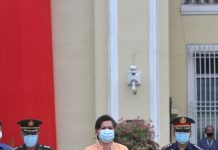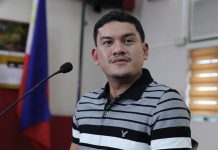Tourism regional director Sonia Garcia has pushed for the adoption of a turtle conservation plan along the beaches of Compostela Valley and the island of Kopiat to protect the rare and endangered marine creature which breeds in the Mabini protected seascapes of Davao gulf.
Garcia bared her advocacy at the opening of the new Cosmopolitan Bar of Beach View Resort in Pindasan, Mabini on the occasion of the 2nd summer beach festival of Compostela Valley last May 8 where she was the guest speaker.
The festival, an annual summer sports project of the province’s association of hotels and resorts, the provincial fitness and sports council, and the provincial tourism office was launched last year with a series of beach sports events, including water volleyball.
“It’s high time that Comval took advantage of its coastline to promote its ecotourism program and to join the advocacy to conserve the rare turtle species that have made the coasts and the nearby Kopiat and Lunod islands their spawning grounds,” Garcia said.
Impressed by the investment Beach View Resort has poured into its operations, the tourism director said the resort could enhance its growth further by embracing a turtle conservation advocacy program that would tap the endangered species as an icon.
Garcia said Beach View Resort, founded in 1991 initially as a private resort of the Omandac family, could organize a tour package that would feature a turtle exhibit, beachcombing and monitoring of the turtle breeding grounds of Kopiat island, and a fireflies tour to, and mangrove immersion in, nearby Lunod island.
The DOT regional director said she had been pushing for what she called a “punta pawikan” initiative among beach resorts in the Davao region and was happy that Beach View was open to the idea.
Eliza Omandac, owner of Beach View, said years ago the resort featured marine turtle viewing but soon after stopped it after they freed the creature back to the sea.
“If the plan pushes through, we would be proud that we in tourism have helped protect these endangered species at the same time promote eco-tourism and the general tourism industry of Compostela Valley,” Christine Dompor, provincial tourism officer, said later.
ComVal’s shoreline
The shoreline of Compostela Valley forms the northern beach strand of Davao Gulf and stretches for some 50 kilometers from the boundary of Tagum City to the coastal town of Maco, and thence to Pantukan on the boundary with Davao Oriental. Mabini lies between the two Compostela Valley towns, with Pindasan hosting the most number of resorts aside from Beach View, like Centro Beach Resort, and Berioso Beach Resorts I and 2. They are just a few of the 20 beach resorts dotting the provincial coastline, including Magnaga Waters and Welborn in Pantukan.
Off the coast of Mabini is the hawksbill-turtle nesting islands of Kopiat and Lunod.
Travel to Kopiat takes about 20 minutes by motorized boat and a tour of the 87-hectare island takes about 45 minutes. A portion of the island embraces a seven-hectare lagoon. The island hosts unspoiled reef areas with rare coral beds that house exotic marine life.
The island is a breeding ground of some of the marine turtle species found in the Davao Gulf: Hawksbill, Oliver Ridley, Green Sea Turtle, Loggerhead, and the Leatherback.
Lunod island, a name derived from the Visayan dialect to mean being submerged, is surrounded by thick growth of mangrove. It has an area of 17 hectares, more than half of which is a submerged mangrove forest and rich coral gardens, spawning grounds for fish, crustaceans, and other marine life that teem in the Mabini seascape.
It takes 15 minutes to reach the island from any point of Mabini. A night tour of the island is a wonderful experience with the tiny glittering lights from fireflies that abound there.
Philippine Environmental Governance Project 2 (EcoGov), a technical assistance project in the Philippines funded by the United States Agency for International Development (USAID), said Davao Gulf is feeding ground to 11 species of cetaceans, including sperm whales, killer whales, and bottle-nosed dolphins.
A number of these species regularly swim the channel between Kopiat and Lunod to feed on the seascape’s seagrasses, rich planktons and krill. It is also a nursing ground to five endangered turtle species, including the hawksbill, the leatherback, and olive ridley.
But sightings of these endangered marine mammals have become rare in the past few years. The Davao Gulf Management Council has warned that some of the world’s most vulnerable and threatened animal species found in Davao Gulf are being pushed further to the brink of extinction. It blames the situation on the lack of concerted initiatives to address environmental concerns in this key biodiversity area (KBA) in the Philippines , listed as one of the world’s 34 biodiversity hotspots.
KBAs, which are considered “globally significant sites,” are building blocks for conservation programs that maintain effective ecological networks and prevent biodiversity loss.
The gulf council, the coordinating body for initiatives to address environmental concerns in the gulf, and composed of 23 local government units, said fragmented initiatives by national government agencies and local government units (LGUs) that deter integrated coastal management, and weak inter LGU mechanisms for coastal and fishery law enforcement were some of the pressing concerns.
“The pressures of economic and social growth have to be addressed through a concerted effort by gulf stakeholders, especially LGUs, because Davao Gulf is the source of livelihood for the people around the gulf,” says Save Davao Gulf Foundation president Leo R. Avila III.






